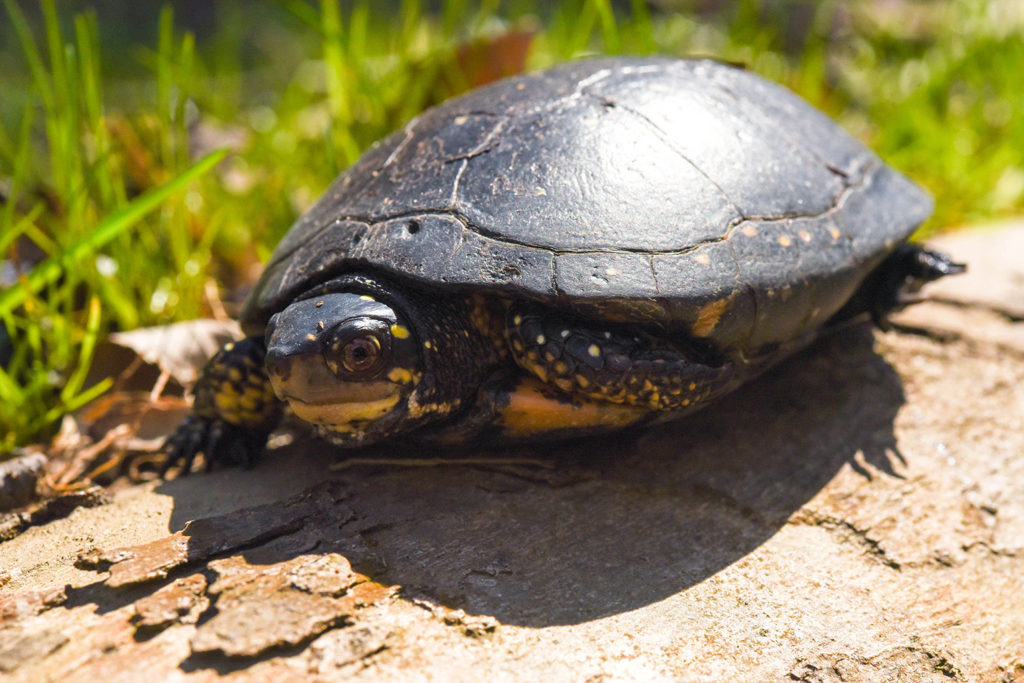Overview
“Where I live”
Spotted turtles are rare and beautiful reptiles native to eastern North America. They inhabit shallow wetlands and exist now in small, isolated populations scattered from southern Canada to Florida.
Visitors to The Maryland Zoo can see spotted turtles in the Giant Tree exhibit in the Maryland Wilderness.
“How I live there”
In the cooler days of spring and fall, spotted turtles are most active. They come out of the water to bask on partially submerged logs, rocks, or grasses, and often bask in a group. They are naturally cautious and will quickly dive underwater to escape disturbance, but will return soon enough to their basking perches. From time to time throughout the day, they will slip into the water and feed. Spotted turtles eat small prey such as snails, worms, slugs, and spiders, and also consume some aquatic vegetation.
During the heat of summer and the cold of winter, spotted turtles are dormant. In summer, they may emerge from the water and seek shelter under tree or shrub roots. They might remain inactive for days or even weeks, conserving energy and reducing their risk of predation in the process. In winter, they bury themselves in mud underwater and hibernate.
“Making my mark”
Spotted turtles are small turtles with dark shells spotted with little yellow polka dots. You can tell a male from a female by the color of the turtle’s eyes. Males have brown eyes and females have red ones.
Raising Young
Almost as soon as spotted turtles emerge from winter hibernation in early spring, males begin courting females. They do so by frantically pursuing females underwater. Several weeks after mating, females go overland in search of appropriate nesting sites. They may not travel far but unfortunately many still are killed crossing roads at this time of year.
A female spotted turtle usually chooses to nest in an open meadow or field. She will dig a depression about 2 inches wide and 2 inches deep in sandy or gravely soil, and lay only a few eggs (usually 3 or 4). She kicks soil onto the nest to cover the eggs, and smoothes the mound down with her plastron (bottom shell) to better protect and conceal it. She then leaves for good.
About eleven weeks later, the baby spotted turtles hatch out. They are tiny and very vulnerable at hatching. They instinctively go in search of tall grass near the edge of a wet meadow or bog, where they can find plenty of food and also remain hidden from potential predators.
“What eats me”
Spotted turtles are small and particularly vulnerable to predation by many animals, most notably raccoons and muskrats.
Conservation
The IUCN, the world’s leading conservation organization, lists spotted turtles as an endangered species. They are protected locally in many states in the U.S., as well as in Ontario and Quebec. The species survives only in isolated, localized populations, many of which are reportedly in decline.
Spotted turtles are threatened mainly by habitat loss and degradation. As habitat loss takes its toll, it becomes even more challenging for each population to sustain itself. This species depends upon long-term reproductive contributions from all adults, so the loss of even a few adults to pet collection or traffic accidents significantly harms a given population.
Taxonomy
- Kingdom: Animalia
- Phylum: Chordata
- Subphylum: Vertebrata
- Class: Reptila
- Order: Testudines
- Family: Emydidae
- Genera: Clemmys
- Species: guttata



